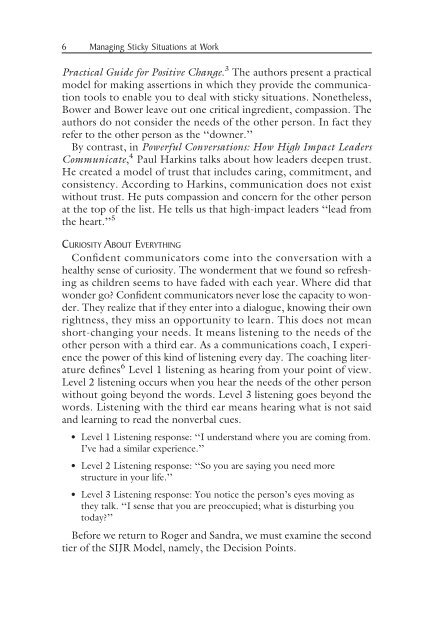Managing Sticky Situations at Work
Managing Sticky Situations at Work
Managing Sticky Situations at Work
You also want an ePaper? Increase the reach of your titles
YUMPU automatically turns print PDFs into web optimized ePapers that Google loves.
6 <strong>Managing</strong> <strong>Sticky</strong> <strong>Situ<strong>at</strong>ions</strong> <strong>at</strong> <strong>Work</strong>Practical Guide for Positive Change. 3 The authors present a practicalmodel for making assertions in which they provide the communic<strong>at</strong>iontools to enable you to deal with sticky situ<strong>at</strong>ions. Nonetheless,Bower and Bower leave out one critical ingredient, compassion. Theauthors do not consider the needs of the other person. In fact theyrefer to the other person as the ‘‘downer.’’By contrast, in Powerful Convers<strong>at</strong>ions: How High Impact LeadersCommunic<strong>at</strong>e, 4 Paul Harkins talks about how leaders deepen trust.He cre<strong>at</strong>ed a model of trust th<strong>at</strong> includes caring, commitment, andconsistency. According to Harkins, communic<strong>at</strong>ion does not existwithout trust. He puts compassion and concern for the other person<strong>at</strong> the top of the list. He tells us th<strong>at</strong> high-impact leaders ‘‘lead fromthe heart.’’ 5CURIOSITY ABOUT EVERYTHINGConfident communic<strong>at</strong>ors come into the convers<strong>at</strong>ion with ahealthy sense of curiosity. The wonderment th<strong>at</strong> we found so refreshingas children seems to have faded with each year. Where did th<strong>at</strong>wonder go? Confident communic<strong>at</strong>ors never lose the capacity to wonder.They realize th<strong>at</strong> if they enter into a dialogue, knowing their ownrightness, they miss an opportunity to learn. This does not meanshort-changing your needs. It means listening to the needs of theother person with a third ear. As a communic<strong>at</strong>ions coach, I experiencethe power of this kind of listening every day. The coaching liter<strong>at</strong>uredefines 6 Level 1 listening as hearing from your point of view.Level 2 listening occurs when you hear the needs of the other personwithout going beyond the words. Level 3 listening goes beyond thewords. Listening with the third ear means hearing wh<strong>at</strong> is not saidand learning to read the nonverbal cues.• Level 1 Listening response: ‘‘I understand where you are coming from.I’ve had a similar experience.’’• Level 2 Listening response: ‘‘So you are saying you need morestructure in your life.’’• Level 3 Listening response: You notice the person’s eyes moving asthey talk. ‘‘I sense th<strong>at</strong> you are preoccupied; wh<strong>at</strong> is disturbing youtoday?’’Before we return to Roger and Sandra, we must examine the secondtier of the SIJR Model, namely, the Decision Points.















